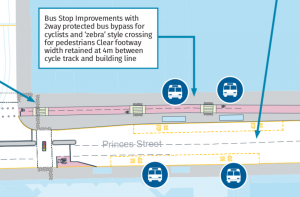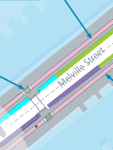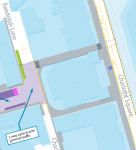LIVING STREETS EDINBURGH RESPONSE: ROSEBURN-LEITH WALK CYCLE ROUTE CONSULTATION
Living Streets Edinburgh (LSE) campaigns for improved conditions for everyday walking in Edinburgh’s streets and public spaces. Walking is the most important transport mode in the city, since over half of all journeys by Edinburgh residents are made either entirely on foot (35%) or by bus (18%), the latter involving a walking stage. It is also the most socially inclusive mode – it’s as natural as breathing – and is critical to the city’s economy (including the important tourist sector).
1. Key principles
1.1 LSE is strongly supportive of measures to improve sustainable transport generally and will support segregated cycle routes where these do not adversely affect the safety and/or convenience of walking, and particularly where they provide general improvements to the walking environment as well. This is the case for the large majority of this route.
 1.2 We have big concerns about ‘floating bus stops’, as – irrespective of any ameliorative measures – there will inevitably be some deterioration in the convenience and safety of walking, as pedestrians have to cross the cycle path from the pavement in order to access the bus stop. Our view is that no floating bus stops should be created in Edinburgh until after the evaluation of a pilot (with multiple safeguards) within the next phase of the Leith Walk upgrade (see separate submission to Anna Harriman at City of Edinburgh Council). Options to avoid these conflicts should be explored.
1.2 We have big concerns about ‘floating bus stops’, as – irrespective of any ameliorative measures – there will inevitably be some deterioration in the convenience and safety of walking, as pedestrians have to cross the cycle path from the pavement in order to access the bus stop. Our view is that no floating bus stops should be created in Edinburgh until after the evaluation of a pilot (with multiple safeguards) within the next phase of the Leith Walk upgrade (see separate submission to Anna Harriman at City of Edinburgh Council). Options to avoid these conflicts should be explored.
1.3 Walking in the city centre and bus use are closely linked. The impact of reduced bus priority needs to be considered in relation to journey times and air pollution impacts on pedestrians. We urge the council to view the project in a multi-modal context, which balances the needs of cyclists with bus users (as well as people on foot) – especially on busy bus routes.
2. General points
2.1 We welcome many of the design proposals for the Roseburn-Leith Walk cycle route as it is clear these will bring some improvements to the pedestrian environment; better crossings of side road junctions and the increased number of non-staggered signaled crossings are particularly to be welcomed.
2.2 We are glad that the new Street Design Guidance has generally been adhered to, with the possible exception of minimum footway widths and frequency of crossing points.
2.3 Whilst referring to the Street Design Guidance on which to base our comments on the scheme, we found it comprehensive, but lacking advice on (a) exactly how to declutter footways, and (b) bus stop design.
2.4 Where pedestrians have to cross the new cycle route (for example, to informal road crossing points) we believe that there should be a greater number of “zebra” type crossings than currently proposed.
2.5 Signaled crossings should include cycle signal heads facing in the direction of the cycle lane to indicate to cyclists on the segregated cycle route that when the signal is red to general traffic it is also red to them (allowing pedestrians to safely cross the carriageway and the cycle route).
2.6 Secondary stop lines at cycle route / footway crossings of priority junctions should be set well back, behind the pedestrian desire line, as well as behind the cycle route.
![]() 2.7 The “buffer zone” between the cycle path and moving or parked cars appears to be rather wide in many locations, such as Melville St or West Coates. Standard practice in Germany, for example, is to keep this to 50cm wide. If it is wider, it creates a great deal of wasted space, sometimes in very constrained locations.
2.7 The “buffer zone” between the cycle path and moving or parked cars appears to be rather wide in many locations, such as Melville St or West Coates. Standard practice in Germany, for example, is to keep this to 50cm wide. If it is wider, it creates a great deal of wasted space, sometimes in very constrained locations.
2.8 This scheme represents a large budget commitment, and at a time when seriously sub-standard footways are widespread across the city, we would expect a project such as this to build in more measures for pedestrians, particularly wider footways. We think it is crucial that evidence is presented that other lower cost means of providing segregated cycling facilities have been explored and appraised alongside the design selected. For example, what would be the cost advantages and the design/user disadvantages of using the same form of segregation as in South College St, Camden in London? How is it that in Germany segregated bike lanes in urban areas can be delivered for €125 per linear metre – why are costs so much more in Edinburgh?
2.9 We assume that all streets involved will be included in the 20 mph zone, which we strongly support.
 2.10 We feel that an eastbound bus lane should be retained / provided at least as far east as Coates Gardens, but recognize that there are constraints thereafter.
2.10 We feel that an eastbound bus lane should be retained / provided at least as far east as Coates Gardens, but recognize that there are constraints thereafter.
3. Specific points (from Roseburn to Charlotte Square)
 3.1 We support segregated cycling routes and complimentary ‘quiet street’ routes where they provide a direct link between Roseburn and the City Centre as part of the Family Friendly network. However, we have serious concerns regarding a short section of segregated cycle route along the north side of Roseburn Terrace (ie the length of the shopping block as far east as the junction with Roseburn Street). Cyclists should be routed via Roseburn Place and Street, as this will produce fewer conflicts with pedestrians (including the proposed ‘floating bus stop’) and will create an evidently better ‘line of route’ fit with the Family Friendly route through Roseburn Park than the option proposed. Roseburn Gardens and the toucan crossing would still provide a link to the proposed cycle facilities across Old Colt Bridge and westwards.
3.1 We support segregated cycling routes and complimentary ‘quiet street’ routes where they provide a direct link between Roseburn and the City Centre as part of the Family Friendly network. However, we have serious concerns regarding a short section of segregated cycle route along the north side of Roseburn Terrace (ie the length of the shopping block as far east as the junction with Roseburn Street). Cyclists should be routed via Roseburn Place and Street, as this will produce fewer conflicts with pedestrians (including the proposed ‘floating bus stop’) and will create an evidently better ‘line of route’ fit with the Family Friendly route through Roseburn Park than the option proposed. Roseburn Gardens and the toucan crossing would still provide a link to the proposed cycle facilities across Old Colt Bridge and westwards.
 3.2 The widening of the footway on the south side of Roseburn Terrace, the conversion of the existing staggered pelican to single stage toucan, and the full pedestrian facilities at the junction with Roseburn St, are all to be welcomed.
3.2 The widening of the footway on the south side of Roseburn Terrace, the conversion of the existing staggered pelican to single stage toucan, and the full pedestrian facilities at the junction with Roseburn St, are all to be welcomed.
3.3 The footway width on the north side of Roseburn Terrace is less than the recommended 3 metres, and is particularly narrow towards the junction with Roseburn St. It should be widened as part of this scheme – and the surface upgraded where required (as should be done on all footways on the route).
 3.4 The scheme should rectify the crossing of the cobbled entrance to the old Murrayfield Station goods yard on the north side of West Coates just west of the cycle path overbridge, and the overly steep crossfall on the crossovers on the entrance to the Cumberland Hotel on West Coates.
3.4 The scheme should rectify the crossing of the cobbled entrance to the old Murrayfield Station goods yard on the north side of West Coates just west of the cycle path overbridge, and the overly steep crossfall on the crossovers on the entrance to the Cumberland Hotel on West Coates.
3.5 There should be at least two additional pedestrian refuges on West Coates between the signaled crossings at Wester Coates Rd and Magdala Crescent.
![]() 3.6 Haymarket Terrace north side footway is less than 3 metres wide between Coates Gardens and Rosebery Crescent – narrow for this category of street and pedestrian flow. Between Magdala Crescent and Coates Gardens the crossfall on the footway is more than 2.5%.
3.6 Haymarket Terrace north side footway is less than 3 metres wide between Coates Gardens and Rosebery Crescent – narrow for this category of street and pedestrian flow. Between Magdala Crescent and Coates Gardens the crossfall on the footway is more than 2.5%.
3.7 There should be at least one additional pedestrian refuge on Haymarket Terrace between Magdala Crescent and Coates Gardens.
3.8  Design of cycle route / footway on Manor Place at junction with Bishops Walk is unclear. There seems to be a missing section of cycle route on the plans just north of the “Copenhagen style” junction.
Design of cycle route / footway on Manor Place at junction with Bishops Walk is unclear. There seems to be a missing section of cycle route on the plans just north of the “Copenhagen style” junction.
3.9 The new informal crossing points of Melville St are most welcome but there should be one additional one equidistant between the junctions of Melville St with Manor Place and Walker St; and one additional between Stafford St and Queensferry St. The kerb buildouts at these points should be slightly wider than the parked cars to maximise pedestrian visibility.
 3.10 Given that the informal zebra crossings of the cycle route at the pedestrian crossing points on Melville St are non-standard (they do not as far as we can ascertain exist in Traffic Signs and General Directions), we suggest trialing non-standard zebras without belisha beacons (as found in many shopping centre car parks and indeed outside the front door of Victoria Quay) right across the carriageway on Melville St at these points, to give crossing pedestrians some priority over both cycles and motor vehicles, and to test this non-standard form of crossing that is commonplace on roads elsewhere in Europe. If absolutely necessary these could be signed with non-standard “Pedestrians crossing on road markings” signs similar to the “Pedestrians crossing on humps” signs found on Shenley Rd, Borehamwood, Hertfordshire.
3.10 Given that the informal zebra crossings of the cycle route at the pedestrian crossing points on Melville St are non-standard (they do not as far as we can ascertain exist in Traffic Signs and General Directions), we suggest trialing non-standard zebras without belisha beacons (as found in many shopping centre car parks and indeed outside the front door of Victoria Quay) right across the carriageway on Melville St at these points, to give crossing pedestrians some priority over both cycles and motor vehicles, and to test this non-standard form of crossing that is commonplace on roads elsewhere in Europe. If absolutely necessary these could be signed with non-standard “Pedestrians crossing on road markings” signs similar to the “Pedestrians crossing on humps” signs found on Shenley Rd, Borehamwood, Hertfordshire.
3.11 The revised pedestrian facilities at the junction of Melville Place and Queensferry St are very welcome.
 3.12 The north side footway on Randolph Place is cluttered with signs and suffers from parked vehicles overhanging it. The streetscape scheme here should deal with this problem, if necessary by use of low bollards. The footways here are poorly maintained and much narrower than the minima in the Street Design Guidance and should be widened.
3.12 The north side footway on Randolph Place is cluttered with signs and suffers from parked vehicles overhanging it. The streetscape scheme here should deal with this problem, if necessary by use of low bollards. The footways here are poorly maintained and much narrower than the minima in the Street Design Guidance and should be widened.
 3.13 It is unclear whether the routes on both sides of West Register House through to Charlotte Square will be shared cycle/pedestrian. We suggest some speed reducing measures for bikes on whichever routes are intended to be open to cyclists.
3.13 It is unclear whether the routes on both sides of West Register House through to Charlotte Square will be shared cycle/pedestrian. We suggest some speed reducing measures for bikes on whichever routes are intended to be open to cyclists.
4. Specific point (Princes Street)
While we have not undertaken a detailed evaluation of most of the proposed route east of Charlotte Square, we strongly oppose the proposal to create a two-way segregated cycleway on what is probably Edinburgh’s busiest footway, on the north side of Princes Street between South St David Street and Leith Street. Whilst we see the potential need for cycling facilities between these points, the space for these must be taken from private motor vehicles and taxis, and not from pedestrians.
The walking environment on Princes Street is already poor in comparison to the main shopping streets of Edinburgh’s competitor cities, with excessively long crossing times, uneven surfaces, low quality materials and badly dropped kerbs, and the last thing it needs is a segregated cycleway taking further space from walkers and causing significant conflicts at pinch-points that are already operating well above their comfortable capacity for pedestrians.
This ill thought-out aspect of the design should be dropped, and alternative future proposals for cycling facilities on Princes Street should be developed in the context of an integrated strategy for the street that has pedestrians – its economic lifeblood – at its heart.
Living Streets Edinburgh Group
1 February 2016
